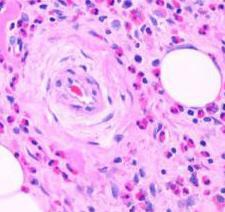 Ezinophils are blood cells that belong to leukocytes and perform an extremely important function of protecting the human body.Immediately after the formation in the bone marrow, the ezinophils enter the bloodstream, and after a few hours they pass to the tissues where they function
Ezinophils are blood cells that belong to leukocytes and perform an extremely important function of protecting the human body.Immediately after the formation in the bone marrow, the ezinophils enter the bloodstream, and after a few hours they pass to the tissues where they function
If there is an infection or a source of inflammation in the body, the ezinophils penetrate to it and activate the special receptors in the cells responsible for immunity.
What does it mean? The situation, when in adults eosinophils are lowered or completely absent in the peripheral blood, is called eosinopenia. In combination with leukocytosis and neutrophileosis of eosinopenia, this indicates an acute inflammatory process in the body and is an indicator of adequate hematopoiesis.
Why do we need eosinophils, and what is it?
Eosinophil granulocytes are a subset of granulocyte blood leukocytes. They received their name because they are stained with a dye eosin in contrast to basophils (stained with basic dyes) and neutrophils (both dyes). Also eosinophils differ in bipartite nucleus, whereas in basophils it is not segmented, and in neutrophils it has 4-5 parts.The main task of eosinophils- to penetrate into the focus of inflammation and activate in it the cellular receptors responsible for antiparasitic immunity. In other words, eosinophils of blood provoke cells around the parasite to self-destruct, thereby surrounding the parasite in a capsule from its membranes. Such capsule becomes a beacon for other, more aggressive cells and substances of the immune system, and tells them where the parasite is.
The norm of the content of eosinophils in the blood
The normal content of eosinophils in the blood of an adult is between 1 and 5% of the total number of leukocytes. At the same time, the indices of these cells are not constant and vary within a day. So, in the daytime their amount in the blood is minimal, and at night, during sleep, maximum.
The determination of the number of eosinophils in the blood is performed using a general (clinical) blood test.
- In an adult and children older than 13 yearsthe number of eosinophils in the blood is from 0.5 to 5% of the number of all leukocytes or 0.02-0.3 x 109 / L.
- Eosinophils in the bloodin children under 13 yearsconstitute from 0.5 to 7%.
In some cases, the determination of eosinophils in sputum is carried out.
Causes of decreased eosinophils in the blood
Why are eosinophils lowered in adults, what does it say? A low level of these blood cells (eosinopenia) means that the bone marrow has been depressed by their production, which is typical for heavy conditions, indicating the depletion of the body's defenses.
Eosinophils in the blood are lowered in the following situations:
- in acute infectious diseases of bacterial genesis (typhoid fever, diphtheria, pneumonia);
- with peritonitis, sepsis, acute appendicitis;
- severe injuries and severe burns; after surgical interventions;
- due to toxic shock; with strong physical overstrain and fatigue;
- emotional stress;
- systematic lack of sleep.
When giving a blood test, remember that the resultThe following factors can affect:
- recent surgery;
- taking medicines;
- recent birth, after which the body did not have time to recover.
If less than two weeks have passed after the above events, eosinophils are likely to be reduced.
In childhood
In children, the absolute number of eosinophils in the blood is 0.05-0.7X109 / L, by 11 years the number of cells is 0-0.6X109 / L. The leukocyte formula takes into account only the percentage ratio of eosinophils. It is these numbers that are of diagnostic importance.
Eosinophils are lowered in the blood in a child can be for the same reasons as an adult. But once again we recall that it is necessary to look not absolute values, but relative ones. Because the norm for children of different ages may vary.
Pregnant women
Normally, eosinophils in the blood are lowered in pregnant women - this is the physiological state of the amount. With the onset of labor and during labor, the number of eosinophils during pregnancy decreases. After 14 days again normalizes.
When you pass the blood test for eosinophils, you should take into account the physiological conditions under which the eosinopenia mentioned above can be observed. The physiological reduction of eosinophils in pregnant women is compensated by the body itself and the number of blood cells will quickly return to normal.
Treatment or any intervention by specialists is required only in case of a pathological decrease in the number of these blood cells.
What to do with eosinopenia
When eosinophils in the blood are lower than normal - this is not a diagnosis, but a condition, most often indicative of a disease. The mechanism of development to date is not entirely clear, there are a lot of reasons for its occurrence. Eosinopenia can be a sign of diseases of a different nature and varying degrees of severity.
Therefore, there is no specific treatment for violation of the level of eosinophils, and all actions are directed to the fight against the disease that provoked it, as well as the adoption of general measures to strengthen immunity.
When the decrease in eosinophils is caused by physiological factors (stress, physical overstrain, etc.), then indicators after a while return to normal on their own, and no action is required.

How to choose probiotics for the intestine: a list of drugs.

Effective and inexpensive cough syrups for children and adults.

Modern non-steroidal anti-inflammatory drugs.

Review of tablets from the increased pressure of the new generation.
 Antiviral drugs are inexpensive and effective.
Antiviral drugs are inexpensive and effective.


